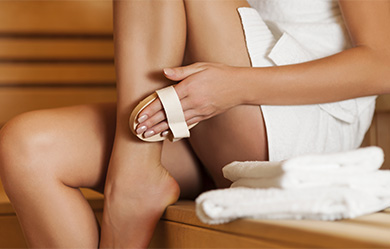Your client’s largest organ is crying out for stimulation this season, writes Ashleigh Sharman.
I love a good scrub and it’s part of my weekly beauty regime but I’ll be honest: dry body brushing has always been a bit of an obstacle. I simply don’t know what I’m doing.
It wasn’t until I experienced dry body brushing as part of a recent professional treatment that my interest was piqued and, with floods of Instagram accounts singing its praises, there is no doubt it belongs on your skin service menu for clients.
Skin, our largest organ, has a lot of work to do and part of that is to excrete the body’s daily impurities (estimated up to one third).
Essentially dry brushing works to help the body in this cleansing process, exfoliating and stimulating the outer layers of the skin by keeping pores clear.
“By stimulating your skin from the outside, you are aiding in the cleansing of your body, increasing blood circulation, assisting in releasing fatty deposits of cellulite under the skin’s surface, buffing off that top layer of dry flaky skin, slowing the ageing process and rejuvenating your skin cells,” says Jodie Smith, owner of Bodecare, which manufactures a range of toxic-free, vegan-friendly brushes made with heat-treated timber.
Jodie advocates its use across a range of treatments, from those that target cellulite to massage, and suggests it can help clients reduce the signs of eczema, psoriasis, keratosis pilaris, mature thin skin, dry skin, acneic skin, and poor circulation.
It wasn’t until I discovered Brisbane-based facialist, and dry body brushing devotee Neralee Flanagan on Instagram, however, that I thought to give it a go myself and this may be how many of your clients are first made aware of the practice.
“It seemed to gain momentum as a popular self-care routine in the wellness world so I thought I would begin to implement it for gentle lymphatic support and general skin health maintenance,” she explains.
Despite no ‘official’ training, Neralee, who started the practice regularly a few years ago, developed her own technique working from the feet up towards to heart.
“I dry body brush a few times a week, prior to showering in the morning as it’s a great way to invigorate the senses and circulatory system, changing from small circular movements to longer sweeping movements depending on how my body is feeling on the day.
 “I follow this with self-massage using warm coconut oil or sesame oil to ensure nourishment follows the exfoliating and detoxification benefits of the brushing.” For clients used to a traditional salt or sugar scrub, the introduction of a body powder scrub with massage oil is a helpful transition to dry body brushing.
“I follow this with self-massage using warm coconut oil or sesame oil to ensure nourishment follows the exfoliating and detoxification benefits of the brushing.” For clients used to a traditional salt or sugar scrub, the introduction of a body powder scrub with massage oil is a helpful transition to dry body brushing.
OmVeda’s detoxifying dry body massage, Udwarthanam, uses a customised herbal mixture to reduce fluid retention and draw out toxins from the body. The powder is sprinkled onto the body, or atop a herbal oil, and firmly massaged in using circular motions.
“Speaking in terms of the true Ayurvedic tradition, Udvartana according to Sushrata is a body toning program, using an application of a combination of prescribed herbal powders and oil on the entire body. The unique ingredients used in the formulation help to remove excess fat, fatigue, and tones the skin by stimulating circulation,” explains OmVeda founder, Yasmin Sadikot who says it can also be used with a natural fibre body brush.
“The Ayurvedic practice of dry body massage has been around for centuries. Every client can benefit from the technique for improved lymphatic health and circulation, oxygenation of the blood, helping to rid the body of toxins and fatigue, improving muscle tone and enhancing skin texture,” she adds.
For Neralee, dry body brushing is a ritual that creates a connection to our bodies. “It’s best done while looking in the mirror to ensure we are taking a moment to really appreciate our body, just as it is!” she says.
And I couldn’t agree more, so whether it’s on your treatment menu or retailed in your business, get clients moving to the beat of the dry body brush.




